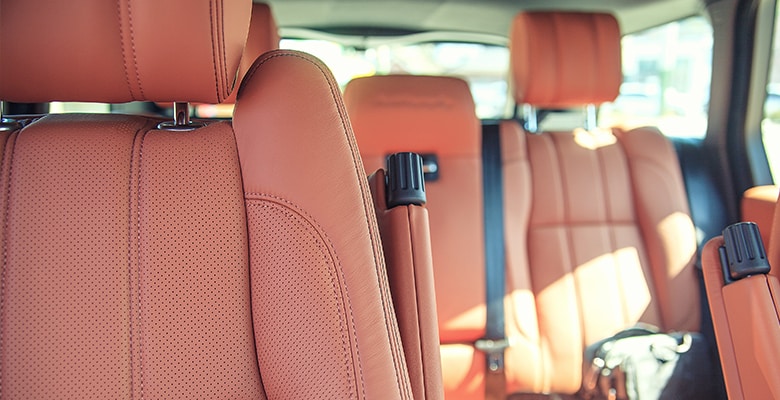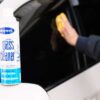The Different Kinds of Leather Interiors and How to Clean Them

Automakers have long used distinctive leatherwork to distinguish their creations from the competition. One classic example was the 1930 Bugatti Type 46 Coupé Superprofilée and its ostrich leather interior. Of course, manufacturers upholstered many early vehicles with a simpler option: vegetable-tanned cow leather. Owners experimented with various oils and greases to protect these leathers. They treated their car seats much like the horse saddles of the day.
Today’s leather interiors are far different, but one thing remains the same. The look and feel remain superior to common cloth and vinyl alternatives. There are many kinds of automotive leather, both real and imagined. In the mid-1970s, actor Ricardo Montalban appeared in a series of now-iconic TV commercials. In a distinctive baritone voice, he hailed the virtues of the rich “Corinthian Leather” found in the Chrysler Cordoba. One day, Montalban appeared on the David Letterman Show. He cheerfully confessed that the term actually referred to nothing at all!
Leather Interiors: Challenges
Your vehicle’s cabin is deserving of some TLC, even if it is not upholstered with that mythical material. It is smart to maintain the leather surfaces to protect your investment as well. Car leathers tend to lose their natural oils over time. Neglected fabric gets brittle. It may crack or even tear. At the same time, contaminants work their way into neglected leather. Heavy discoloration often follows.
Abrasion is another problem. Think sandpaper, and then think about your beautiful leather seats. As you move in and out of your vehicle, sharp-edged particulates get dragged along. Over time, unprotected leather is vulnerable to abrasions and scratching. Acidic body oils are another concern. While a neutral pH is 7, the oil secreted by human sebaceous glands is quite acidic, with a pH of 5.5.
Cracking and stretching are other challenges. As leather surfaces age, microscopic cracks often appear. These are evidence of drying. It is important to apply a conditioner to restore leather’s natural oils. Aging leather also tends to stretch near seams and around folds. Regular applications of a quality leather conditioner keep the material soft and supple.
Different Automotive Leathers
If you have a leather interior in your vehicle, it’s important to know how to clean it. You’ll want to match the cleaning mode with the type of leather in your vehicle. Your leather upholstery will either be pigmented, semi-aniline, or aniline. If it appears to be suede leather, it’s likely faux suede, a synthetic alternative.
Pigmented leather
Pigmented leather is also referred to as protected or coated leather. Pigmented leather interiors are fashioned from natural rather than dyed hides. Opaque pigments dictate surface color. Automakers have the freedom to select from an endless array of pigmented colors. This allows for precise color matching of carpeting, interior appointments, and exterior finishes.
There are two types of pigmented leather. One features a thin coating, the other a much thicker coating. A thin synthetic coating retains the natural feel of the leather, but it will not mask defects. In general, you’ll find thinner protective coatings on more expensive leather interiors. A thicker synthetic coating allows the use of lower-quality hides. Thicker coatings often feel stiffer – more like vinyl.
Semi-aniline leather
Semi-aniline automotive leathers are both practical and beautiful. Automakers use dyed hides for semi-aniline leather interiors. A very thin protective layer protects the surface. The tinted, dyed or clear coating does not mask blemishes. Therefore, automakers must use blemish-free, premium hides that are more expensive.
Aniline leather
Aniline leathers are extremely soft and supple. They are mostly found in ultra-luxury vehicles. For example, Audi used aniline leather in some of its premium models. Some vintage cars also featured the luxurious leather. It is sometimes used in high-end restorations of such vehicles.
While both the look and feel of aniline leather are wonderful, there is a key drawback. There’s no protective coating whatsoever. As a result, aniline leather interiors are vulnerable to damage. Scratching, staining, dye transfer, stiffness and water damage are all possible. So is discoloring from contact with greasy food and drinks like coffee.
Suede leather and faux suede
You’ll find what appears to be suede leather on certain high-end sports cars and luxury makes. Usually, it is actually Alcantara or another synthetic microfiber. Racing teams like Alcantara, microsuede, and Ultrasuede because they are lightweight, fire-resistant materials. You’ll also find Alcantara in some luxury performance vehicles. For example, Alcantara is standard on many Audi RS and Mercedes AMG models. It’s also an option on the BMW M-Sport and Toyota GT86.
Caring for Automotive Leathers
It is important to frequently vacuum all leather interiors. This limits the build-up of soil and grime that would otherwise work its way into the surface. Use a gentle, water-based cleaner to remove embedded dirt and oil. Finally, use a conditioner with protectants to reduce abrasion. Conditioned leathers better resist the adverse effects of UV sunlight. An all-in-one leather cleaner and conditioner simplifies the process.
Semi-aniline leather is not quite as resilient as pigmented leather. You’ll want to rely on frequent conditioning to keep it supple.
Clean aniline leather with extreme care. The porous, unprotected surface is vulnerable to staining and soiling. At the same time, the elegant, rich feel blends well with luxury performance vehicles. In all cases, it is vital to clean aniline leathers using cleaners that are specifically labeled for aniline leather use.
To clean suede and suede-like fabrics, you’ll want to use a foam-action cleaner to avoid heavy scrubbing. It’s important to let the ingredients do the work on these more vulnerable surfaces.
Leather Care Products
Premium Sprayway leather care products address everything from challenging spot removal to proactive leather care. Regular leather cleaning and conditioning make for a more enjoyable car interior. They also protect your investment until the time comes to sell it or trade it in.
Sprayway Auto Leather Cleaner & Conditioner
Sprayway Auto Leather Cleaner & Conditioner provides complete single-step leather care. The rich mousse-like foam is easy to apply. A careful blend of quality ingredients cleans, conditions and preserve older and newer leathers alike. The water-repellent formula prevents future water spotting and salt stains. It imparts a fresh leather fragrance to your vehicle’s interior. Use it on a wide array of exotic and fine leathers without fear of darkening or stickiness.
Car Leather Care: Concluding Thoughts
Your vehicle’s leather interior is likely the pigmented or semi-aniline type. In all cases, be proactive about maintaining leather seats and appointments. Vacuum often, and get after any spots or stains as soon as they appear. Frequently apply a quality leather conditioner to restore moisture and to keep your upholstery soft and supple.
Give your automotive leather a little TLC, and your passengers will enjoy a more pleasant, even luxurious ride. Finally, realize that diligent leather care often translates into a better offer when it’s time to sell or trade-in your vehicle
Recent Post

Water-based Cleaners vs Solvent-based...

The Different Kinds of Tinted Windows...
